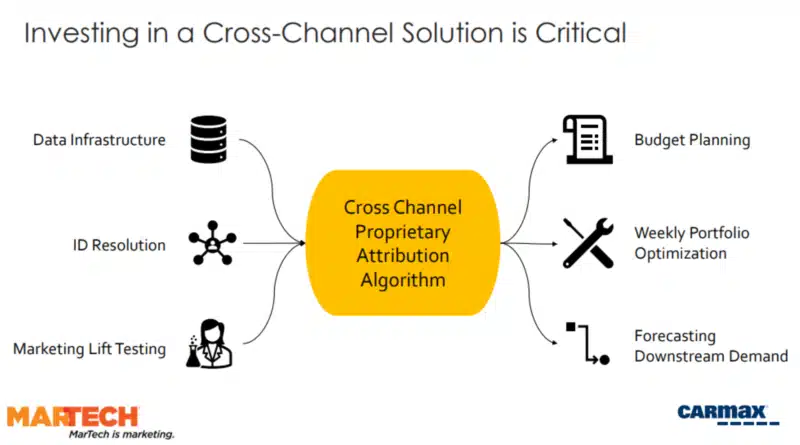Using analytics to optimize marketing spend and drive sales
CarMax maps out their growing omnichannel marketing analytics strategy.
“Our No. 1 goal is to understand the impact that our marketing dollars have to company sales and how to maximize that impact,” said Shawn Petrou, director, digital acquisition analytics for CarMax at its recent presentation at The MarTech Conference.
The used car retailer uses analytics to optimize the increasing number of programs connecting customers at over 220 physical stores and online.
More need for analytics as channels increase
“New platforms become mainstream every couple of years, which provides more opportunities for marketing platforms,” said Petrou. “But it also creates a lot of complexity.”
Gone are the days of simple direct mail and email campaigns. Rapid-fire cross-channel digital campaigns drive sales efficiently if they’re optimized. But first, marketers need to be able to track and analyze each component of their marketing programs.
Cross-device ID graphs enable marketers to identity the impact of different channels, even when customers are using multiple devices, including phones, tablets and laptops.
Align sales and marketing teams
Successful marketing campaigns require all stakeholders to be aligned. This includes marketing and sales teams, and even the CFO, Petrou said.
“This type of alignment across the board allows for your analytics solution to truly have an impact on your sales as well as your bottom line,” he explained.
Make sure teams and individual members of the organization work together to get the most mileage out of your tech tools, including analytics.

Cross-channel measurement
CarMax built their own cross-channel attribution algorithm. According to the team, it requires regular updating and maintenance to make sure it measures values on each channel accurately.
These measurements are critical when making decisions about investments for ongoing and future campaigns.
Brad Goldschmidt, CarMax senior manager, marketing analytics, named three main inputs to attribution:
- First-party customer data and third-party data within a solid data infrastructure
- ID resolution to accurate attribute credit to a specific channel
- Structured marketing lift tests
Customer data and identity resolution allow CarMax to connect sales to all the touchpoints that moved the needle.
Dig deeper: Marketing Analytics…what is it and why do you need it?
Marketing optimization with structured testing
“We run structured marketing lift tests across our major programs to validate the incremental value they are delivering,” said Goldschmidt. “These tests help us answer the question of what would have happened had our customers not been exposed to our advertising.”
The tests include in-house approaches, as well as platform-specific tests. Major platforms will allow for audiences to be randomly assigned to test control populations.
“Then, after the test, first-party data can then be matched back to those platform audiences to understand the true lift,” Goldschmidt said.
So, again, it goes back to having solid customer data, as well as strong data pipelines with partners.
“Once we have these distinct insights for each of our programs, we can measure the fractional credit for each area,” he added.
Attribution
“The actual attribution process is where you combine all the factors to determine the fractional credit for marketing,” said Goldschmidt.
Some of these factors include the marketing channel, timing, sequence and interaction with other programs.
“When designing our process, we consider the usable approaches of first- or last-touch attribution,” he explained. “We thought that was too simple though, and didn’t really represent the behaviors of all of our customers.”
CarMax chose to use a dynamic attribution weighting model that considers all the interaction points, and used the result from the marketing lift tests to further isolate the credit for each program underway.
“The net result of this is a more sophisticated weighting that can handle the diverse and numerous paths that our customers follow,” said Goldschmidt.
Because it’s a cross-channel solution, it avoids the risk of double-counting individual actions on multiple channels.
“This is especially important as your marketing mix shifts over time,” he said. “And our process is designed in such a way to kind of adjust those weights as we see these shifts.”
Using analytics to optimize your marketing portfolio in a digital world from Third Door Media on Vimeo.
Related stories